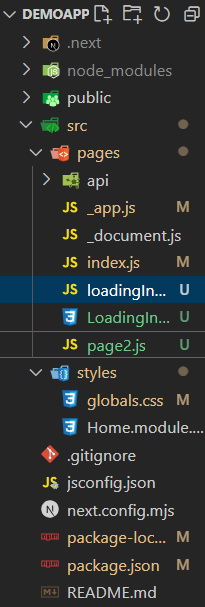|
To experience smooth transitions between the pages of your Next.js application, you can include a loading indicator that shows the progress of the page being loaded. This can be done by creating a custom spinner component and using it during page transitions.
In this article, we will create a custom spinner component and display it between page transitions in a Next.js application.
Approach to Handle Loading Between Page Changes in Next.js- Create the Spinner Component: Create a new file named loadingIndicator.js inside the pages. This is a simple component we bring the life to this component with our CSS.
- Style the Loading Indicator: Using CSS, we will style the above component that purely transforms itself into a spinner.
- Create another page to navigate and test our loading spinner while transitioning between pages.
- Integrating the Loading Indicator: To integrate the loading indicator, we will modify the _app.js file. This file acts as the top-level component in your Next.js app and is ideal for managing global states like a loading indicator.
- Modify _app.js: Open the pages/_app.js file and update it as follows:
- A delay of 2000 milliseconds is added before hiding the loading indicator. This ensures that the indicator is visible for a short period, even for fast transitions.
Steps to Create NextJS AppStep 1: Create a Next.Js project with the following commands in your desired location with the desired project name.
npx create-next-app demoapp
cd demoapp Step 2: Start the Development Server:
npm run dev Step 3: Create the following files required to execute our example that shows how to handle loading between pages.
pages/loadingIndicator.js
pages/LoadingIndicator.module.css
pages/page2.js Project structure demoapp structure Example: Below is an example to handle loading between pafe changes in Next.js.
CSS
/* pages/LoadingIndicator.module.css */
.loadingindicator {
position: fixed;
top: 0;
left: 0;
width: 100%;
height: 100%;
display: flex;
justify-content: center;
align-items: center;
background: rgba(255, 255, 255, 0.8);
z-index: 9999;
font-size: 20px;
color: #000;
}
.spinner {
border: 4px solid rgba(0, 0, 0, 0.1);
border-left-color: #000;
border-radius: 50%;
width: 40px;
height: 40px;
animation: spin 1s linear infinite;
margin-right: 10px;
}
@keyframes spin {
0% {
transform: rotate(0deg);
}
100% {
transform: rotate(360deg);
}
}
// pages/LoadingIndicator.js
import React from "react";
//Create a CSS file for styling
import style from "./LoadingIndicator.module.css";
const LoadingIndicator = () => (
<div className={style.loadingindicator}>
<div className={style.spinner}></div>
Loading...
</div>
);
export default LoadingIndicator;
// pages/page2.js
import React from "react";
function page2() {
return (
<div style={{
height: "100vh",
fontSize: "50px",
backgroundColor: "grey"
}}>
<h2>this is page 2</h2>
</div>
);
}
export default page2;
// pages/_app.js
import "@/styles/globals.css";
import Router from "next/router";
import { useState, useEffect } from "react";
import LoadingIndicator from "./loadingIndicator";
function MyApp({ Component, pageProps }) {
const [loading, setLoading] = useState(false);
useEffect(() => {
const handleStart = () => setLoading(true);
const handleComplete = () => {
// Adding a delay before setting loading to false
setTimeout(() => setLoading(false), 2000); // 500ms delay
};
Router.events.on("routeChangeStart", handleStart);
Router.events.on("routeChangeComplete", handleComplete);
Router.events.on("routeChangeError", handleComplete);
return () => {
Router.events.off("routeChangeStart", handleStart);
Router.events.off("routeChangeComplete", handleComplete);
Router.events.off("routeChangeError", handleComplete);
};
}, []);
return (
<>
{loading && <LoadingIndicator />}
{!loading && <Component {...pageProps} />}
</>
);
}
export default MyApp;
// pages/index.js
import { useRouter } from "next/router";
import React from "react";
function Index() {
const router = useRouter();
return (
<div style={{ fontSize: "50px" }}>
<h2>This is page 1</h2>
<input
type="button"
value="Click me"
style={{ fontSize: "30px" }}
onClick={() => {
router.push("/page2");
}}
/>
</div>
);
}
export default Index;
Output:
Best Practices and Tips- Consistent User Experience: Ensure that the loading indicator is consistently shown during all page transitions. This provides a uniform user experience across your app.
- Performance Considerations: Be mindful of the performance impact. While the loading indicator enhances user experience, it should not significantly slow down transitions.
- Adjustable Delay: The delay time before hiding the loading indicator can be adjusted based on your app’s needs. Too short a delay may make the indicator flash briefly, while too long a delay might make transitions feel slow.
Alternative Approach Using External Packages1. Install nprogress:
npm install nprogress 2. Verify dependencies.
"dependencies": {
"next": "14.2.3",
"nprogress": "^0.2.0",
"react": "^18",
"react-dom": "^18",
"web3": "^4.8.0"
}3. Set Up nprogress in _app.js:
JavaScript
//pages/_app.js
import "nprogress/nprogress.css";
import NProgress from "nprogress";
import Router from "next/router";
import { useEffect } from "react";
import "../styles/globals.css";
function MyApp({ Component, pageProps }) {
useEffect(() => {
const handleStart = () => NProgress.start();
const handleComplete = () => NProgress.done();
Router.events.on("routeChangeStart", handleStart);
Router.events.on("routeChangeComplete", handleComplete);
Router.events.on("routeChangeError", handleComplete);
return () => {
Router.events.off("routeChangeStart", handleStart);
Router.events.off("routeChangeComplete", handleComplete);
Router.events.off("routeChangeError", handleComplete);
};
}, []);
return <Component {...pageProps} />;
}
export default MyApp;
Output:
Conclusion:Displaying a loading indicator during page transitions in Next.js significantly enhances user experience by providing visual feedback. Whether you implement a custom solution or use an external package like nprogress, ensure that your implementation is smooth and does not negatively impact performance. By following this guide, you can create a more polished and user-friendly application.
|

